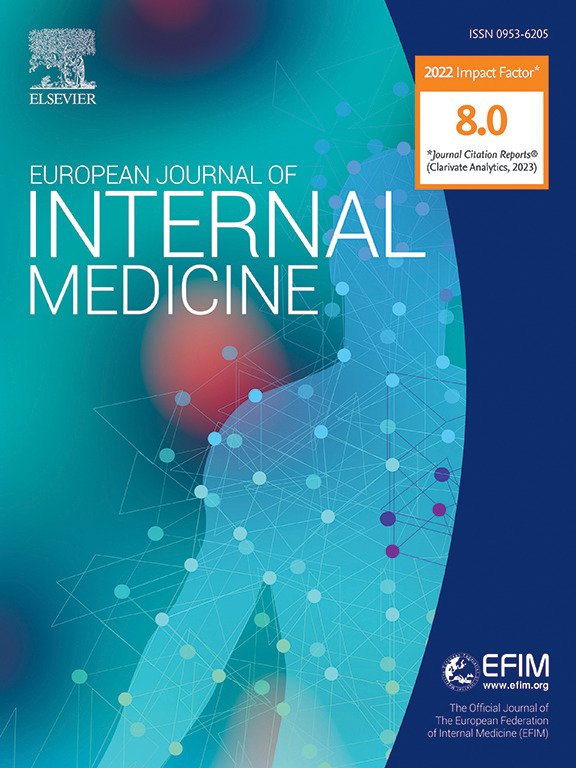Prevalence and impact of multidrug resistance in a cohort of patients admitted to emergency department for urinary tract-infections: The UTILY study, a prospective multicentre study
IF 5.9
2区 医学
Q1 MEDICINE, GENERAL & INTERNAL
引用次数: 0
Abstract
Background and aim
The aim of the present study was to evaluate the prevalence and to identify the independent predictors of multi-drug resistance among a cohort of patients admitted to emergency department for urinary tract infections (UTI), and to assess the impact of antimicrobial resistance on the clinical outcomes.
Methods
We conducted a prospective multicentre study enrolling all adult patients admitted to one of the eight emergency departments participating in the study with a microbiologically confirmed diagnosis of UTI from February 2023 to July 2024. The primary outcome evaluated was 30-day mortality; secondary outcomes included 7-day mortality and clinical response.
Results
During the study period, 681 patients were admitted to one of the 8 participating facilities with signs and symptoms consistent with UTI, 327 of which presented a positive urine culture and were included in the study. A total of 128 out of 327 patients (39.1 %) had an isolation of an MDR organism. At multivariate analysis, male gender (OR 1.79, 95 % CI 1.08–2.97, p = 0.024) and hospital admission during the previous 90 days (OR 4.28, 95 % CI 1.86–9.83, p = 0,001) resulted independently associated with the isolation of an MDR pathogen. Regarding clinical outcomes, the presence of sepsis or septic shock (OR 6.25, 95 % CI 1.36–28.73, p = 0.019), and being infected with an MDR pathogen (OR 2.65, 95 % CI 1.01–6.97, p = 0.048) resulted the only variables independently associated with 30-day mortality.
Conclusions
Our study has reported a 39.1 % prevalence of MDR pathogens in patients admitted to emergency departments for UTI, with a 21 % prevalence among patients without any known risk factor.
尿路感染急诊科住院患者多药耐药的患病率和影响:utly研究,一项前瞻性多中心研究。
背景与目的:本研究的目的是评估急诊科尿路感染(UTI)患者多药耐药的患病率和独立预测因素,并评估抗菌药物耐药对临床结果的影响。方法:我们进行了一项前瞻性多中心研究,纳入了2023年2月至2024年7月期间在参与研究的8个急诊科之一接受微生物学证实诊断为UTI的所有成年患者。评估的主要结局是30天死亡率;次要结局包括7天死亡率和临床反应。结果:在研究期间,共有681名症状和体征与尿路感染相符的患者入住8家参与机构之一,其中327名尿培养阳性患者被纳入研究。327例患者中有128例(39.1%)分离出耐多药病原菌。在多变量分析中,男性性别(OR 1.79, 95% CI 1.08-2.97, p = 0.024)和前90天的住院情况(OR 4.28, 95% CI 1.86-9.83, p = 0.001)与MDR病原菌的分离独立相关。至于临床结果,败血症或感染性休克(or 6.25, 95% CI 1.36-28.73, p = 0.019)和感染耐多药病原体(or 2.65, 95% CI 1.01-6.97, p = 0.048)是与30天死亡率独立相关的唯一变量。结论:我们的研究报告了因尿路感染而进入急诊科的患者中耐多药病原体的患病率为39.1%,而在没有任何已知危险因素的患者中患病率为21%。
本文章由计算机程序翻译,如有差异,请以英文原文为准。
求助全文
约1分钟内获得全文
求助全文
来源期刊
CiteScore
9.60
自引率
6.20%
发文量
364
审稿时长
20 days
期刊介绍:
The European Journal of Internal Medicine serves as the official journal of the European Federation of Internal Medicine and is the primary scientific reference for European academic and non-academic internists. It is dedicated to advancing science and practice in internal medicine across Europe. The journal publishes original articles, editorials, reviews, internal medicine flashcards, and other relevant information in the field. Both translational medicine and clinical studies are emphasized. EJIM aspires to be a leading platform for excellent clinical studies, with a focus on enhancing the quality of healthcare in European hospitals.

 求助内容:
求助内容: 应助结果提醒方式:
应助结果提醒方式:


